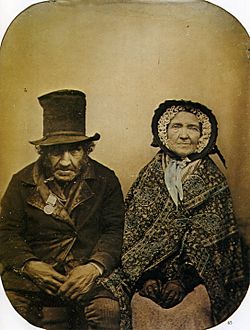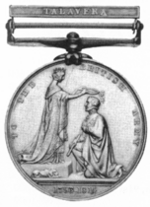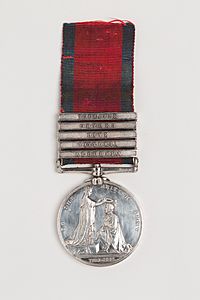Military General Service Medal facts for kids
The Military General Service Medal (often called the MGSM) was a special award given to soldiers in the British Army. It was created in 1847 and first given out in 1848. This medal was for soldiers who had fought in various wars and battles between 1793 and 1814.
This time period included the French Revolutionary Wars, the Napoleonic Wars, and the War of 1812 against America. For each battle or campaign a soldier fought in, they could get a small metal bar called a "clasp" to wear on the medal's ribbon. There were 29 different clasps approved, and one soldier even received 15 of them!

The idea for the Military General Service Medal came from Charles Gordon-Lennox, 5th Duke of Richmond. He had fought in the famous Battle of Waterloo. He worked hard in the British Parliament to make sure that all soldiers who had survived these old campaigns would finally get a medal. He even got Queen Victoria interested, and she helped convince the Duke of Wellington that regular soldiers deserved this recognition. Before this, only the Waterloo Medal was given to all ranks, and only high-ranking officers received the Army Gold Medal for their service in the Napoleonic Wars.
The MGSM was only given to soldiers who were still alive to claim it. Many soldiers did not apply for the medal. This was partly because many couldn't read or write, and also because not enough people knew about the new medal. Because of this, only about 10 out of every 100 soldiers who served actually received the medal. If a soldier applied for the medal but then passed away before it was given, their family would still receive it.
In total, 26,089 of these medals were awarded.
The Military General Service Medal and its partner, the Naval General Service Medal (for sailors), were some of the first "campaign medals" in Britain. This means they were given to all soldiers and sailors who were part of a specific battle or campaign, not just the officers. Earlier medals, like the Army Gold Medal, were only for high-ranking officers who led successful missions. To tell them apart, the MGSM was often called the "silver medal."
What the Medal Looks Like
The medal was designed by an artist named William Wyon. It is made of silver and is about 36 millimeters (or 1.4 inches) wide.
- Front (Obverse): It shows a picture of Queen Victoria looking to the left. Around her, it says "VICTORIA REGINA" (which means "Queen Victoria") and the year "1848."
- Back (Reverse): This side shows Queen Victoria standing on a platform. She is placing a laurel wreath (a symbol of victory) on the head of a kneeling Duke of Wellington. Above them, it says "TO THE BRITISH ARMY," and below are the dates "1793-1814."
- Naming: The name of the soldier and their regiment (their army unit) were carved into the edge of the medal in capital letters.
- Ribbon: The ribbon is about 32 millimeters (or 1.25 inches) wide. It is a bright crimson red with dark blue edges. This "military ribbon" was also used for other important awards like the Army Gold Medal and the Waterloo Medal.
Clasps: Showing Your Battles
The clasps are small metal bars that attach to the medal's ribbon. Each clasp represents a specific battle or campaign the soldier fought in. Even though the medal covers the years 1793 to 1814, no clasps were given for service before 1801, or between 1802 and 1805.
Many of the clasps (21 of them) were for battles during the Peninsular War in Spain and Portugal. Three clasps were for battles in the War of 1812 in North America. The medal was always given with at least one clasp. The most clasps ever awarded to one person was 15!
Here are some of the clasps that were awarded:
- Egypt (This clasp was approved in 1850)
- Maida
- Roleia
- Vimiera
- Sahagun
- Benevente
- Sahagun and Benevente (If a soldier was at both battles)
- Corunna
- Martinique
- Talavera
- Guadaloupe
- Busaco
- Barrosa
- Fuentes D'Onor
- Albuhera
- Java
- Ciudad Rodrigo
- Badajoz
- Salamanca
- Fort Detroit
- Vittoria
- Pyrenees
- St Sebastien
- Chateauguay
- Nivelle
- Chrysler's Farm
- Nive
- Orthes
- Toulouse




